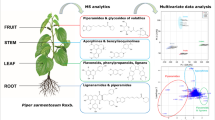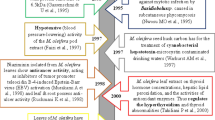Abstract
The primary objective of this study is to perform a comparative analysis of the trace element content of the leaves and roots of three Plantago species (P. maxima Juss. ex Jacq., P. major L., and P. lanceolata L.). Trace element levels were assessed by inductively coupled plasma mass spectrometry. The data indicate that the leaves of P. lanceolata are characterized by the highest Co, Cr, and Se content, whereas P. maxima leaves contained the greatest levels of Si and Zn. In contrast, the highest concentrations of Co, Cr, Fe, I, Mn, Si, and V were detected in the roots of P. major. Zn content was also higher in P. maxima roots than in the other species analyzed. The toxic trace elements were differentially distributed across the studied species. In particular, P. lanceolata leaves contained significantly higher Al, As, Li, Ni, Pb, and Sr levels, whereas the B and Cd content was elevated in P. major as compared to the other species. Surprisingly, the leaf Hg level was the lowest in P. major, whose levels of Al, As, B, Cd, Ni, Li, and Sr were significantly higher than the other two species. The data indicate that the concentration of most of the essential trace elements was higher in the leaves and roots of P. major and P. lanceolata than in P. maxima, while P. maxima had less toxic metals. The obtained data on trace elements content in Plantago tissues may be taken into account while using plant preparations in practical medicine.
Similar content being viewed by others
References
Fraga CG (2005) Relevance, essentiality and toxicity of trace elements in human health. Mol Aspects Med 26:235–244
Jomova K, Valko M (2011) Advances in metal-induced oxidative stress and human disease. Toxicology 283(2):65–87
Chen YW, Yang CY, Huang CF, Hung DZ, Leung YM, Liu SH (2009) Heavy metals, islet function and diabetes development. Islets 1(3):169–176
Agarwal S, Zaman T, Tuzcu EM, Kapadia SR (2011) Heavy metals and cardiovascular disease: results from the national health and nutrition examination survey (NHANES) 1999–2006. Angiology 62(5):422–429
Jomova K, Vondrakova D, Lawson M, Valko M (2010) Metals, oxidative stress and neurodegenerative disorders. Mol Cell Biochem 345(1–2):91–104
Ahmad I, Aqil F, Owais M (2006) Modern phytomedicine: turning medicinal plants into drugs. Wiley, Germany
Beara IN, Lesjak MM, Jovin ED, Balog KJ, Anackov GT, Orcić DZ, Mimica-Dukić NM (2009) Plantain (Plantago L.) species as novel sources of flavonoid antioxidants. J Agric Food Chem 57(19):9268–73
Taskova R, Handjieva N, Evstatieva L, Popov S (1999) Iridoid glucosides from Plantago cornuti, Plantago major and Veronica cymbalaria. Phytochemistry 52:1443–1445
Jamilah J, Sharifa AA, Sharifah NRSA (2012) GC-MS analysis of various extracts from leaf of Plantago major used as traditional medicine. World Appl Sci J 17:67–70
Zhou Q, Lu W, Niu Y, Liu J, Zhang X, Gao B, Akoh CC, Shi H, Yu L (2013) Identification and quantification of phytochemical composition and anti-inflammatory, cellular antioxidant, and radical scavenging activities of 12 Plantago species. J Agric Food Chem 61(27):6693–6702
Beara IN, Orčić DZ, Lesjak MM, Mimica-Dukić NM, Peković BA, Popović MR (2010) Liquid chromatography/tandem mass spectrometry study of anti-inflammatory activity of Plantain (Plantago L.) species. J Pharmaceut Biomed 52(5):01–706
Tinkov AA, Nemereshina ON, Popova EV, Polyakova VS, Gritsenko VA, Nikonorov AA (2014) Plantago maxima leaves extract inhibits adipogenic action of a high-fat diet in female Wistar rats. Eur J Nutr 53:831–842
Beara IN, Lesjak MM, Četojević-Simin DD, Orčić DZ, Janković T, Anačkov GT, Mimica-Dukić NM (2012) Phenolic profile, antioxidant, anti-inflammatory and cytotoxic activities of endemic Plantago reniformis G. Beck. Food Res Int 49:501–507
Beara IN, Lesjak MM, Orčić DZ, Simin NĐ, Četojević-Simin DD, Božin BN, Mimica-Dukić NM (2012) Comparative analysis of phenolic profile, antioxidant, anti-inflammatory and cytotoxic activity of two closely-related Plantain species: Plantago altissima L. and Plantago lanceolata L. LWT-Food Sci Technol 47:64–70
Palmeiro NS, Almeida CE, Ghedini PC, Goulart LS, Baldisserotto B (2002) Analgesic and anti-inflammatory properties of Plantago australis hydroalcoholic extract. Acta Farm Bonaer 21:89–92
Barua CC, Pal SK, Roy JD, Buragohain B, Talukdar A, Barua AG, Borah P (2011) Studies on the anti-inflammatory properties of Plantago erosa leaf extract in rodents. J Ethnopharmacol 134:62–66
Yoon JY, Sim JY, Kim SS, Jong C (2003) Anti-inflammatory and analgesic activity of fractions of Plantago asiatica herb. Chung-Ang J Pharmacal Sci 17:129–147
Beara I, Lesjak M, Jovin E, Balog K, Orčić D, Simin N, Mimica-Dukić N (2009) Plantago holosteum Scop. as a potential natural antioxidant and antiinflammatory agent. Planta Med 75:44
Rodríguez-Cabezas ME, Galvez J, Camuesco D, Lorente MD, Concha A, Martinez-Augustin O, Redondo L, Zarzuelo A (2003) Intestinal anti-inflammatory activity of dietary fiber (Plantago ovata seeds) in HLA-B27 transgenic rats. Clin Nutr 22:463–471
Samuelsen AB (2007) The traditional uses, chemical constituents and biological activities of Plantago major L. A review. J Ethnopharmacol 71(1):1–21
Bosse GG (1942) Wild plants for needs of defense. Sci Life 1:34–38 [In Russian]
Filipović-Trajković R, Ilić ZS, Šunić L, Andjelković S (2012) The potential of different plant species for heavy metals accumulation and distribution. J Food Agric Environ 10(1):959–964
Prasad AS (2008) Clinical, immunological, anti-inflammatory and antioxidant roles of zinc. Exp Geront 43(5):370–377
Duntas LH (2009) Selenium and inflammation: underlying anti-inflammatory mechanisms. Horm Metab Res 41:443–447
Petrova S, Velcheva I, Yurukova I, Berova M (2014) Plantago lanceolata L. as a biomonitor of trace elements in an urban area. Bulg J Agric Sci 20:325–26
Haddadian K, Haddadian K, Zahmatkash M (2013) A review of Plantago plant. Indian J Tradit Know 13(4):681–5
Bhanisana Devi RK, Sarma HNK (2013) Profile of trace elements in selected medicinal plants of North East India. IOSR-JAP 4(3):47–51
Kurteva MK (2009) Comparative study on Plantago major and P. lanceolata (Plantaginaceae) as bioindicators of the pollution in the region of the Asarel Copper Dressing Works. Phytol Balcan 15(2):261–71
Rábai M, Nagy NV, May Z, Szentmihályi K (2012) Microelements in drug and extracts of Plantago lanceolata L. ECB 1(7):280–283
Nagórska-Socha A, Ptasinski B, Kita A (2013) Heavy metal bioaccumulation and antioxidative responses in Cardaminopsis arenosa and Plantago lanceolata leaves from metalliferous and non-metalliferous sites: a field study. Ecotoxicology 22:1422–34
Mazur Z, Radziemska M, Fronczyk J, Jeznach J (2015) Heavy metal accumulation in bioindicators of pollution in urban areas of northeastern Poland. FEB 24(1):216–23
Kulhari A, Sheorayan A, Bajar S, Sarkar S, Chaudhury A, Kalia RK (2013) Investigation of heavy metals in frequently utilized medicinal plants collected from environmentally diverse locations of north western India. SpringerPlus 2:676
Maobe MAG, Gatebe E, Gitu L, Rotich H (2012) Profile of heavy metals in selected medicinal plants used for the treatment of diabetes, malaria and pneumonia in Kisii Region, Southwest Kenya. GJP 6(3):245–51
Tokalioglu S (2012) Determination of trace elements in commonly consumed medicinal herbs by ICP-MS and multivariate analysis. Food Chem 134(4):2504–8
Raczuk J, Biardzka E, Daruk J (2008) The content of Ca, Mg, Fe and Cu in selected species of herbs and herb infusions. PZH 59(1):33–40
Suliburska J, Kaczmarek K (2012) Herbal infusions as a source of calcium, magnesium, iron, zinc and copper in human nutrition. Int J Food Sci Nutr 63(2):194–8
Patel P, Patel NM, Patel PM (2011) WHO guidelines on quality control of herbal medicines. IJRAP 2(4):1148–54
Siedlecka A (1995) Some aspects of interactions between heavy metals and plant mineral nutrients. Acta Soc Bot Pol 64:265–272
Chang X, Duan C, Wang H (2000) Root excretion and plant resistance to metal toxicity. Ying Yong Sheng Tai Xue Bao 11:315–20 [In Chinese]
Weston LA (2003) Root exudates: an overview. In: De Kroon H, Wisser EJW (eds) Root ecology. Springer, Berlin Heidelberg, pp 235–255
Badri DV, Vivanco JM (2009) Regulation and function of root exudates. Plant Cell Environ 32:666–681
Scalbert A, Mila I, Expert D, Marmolle F, Albrecht AM, Hurrell R, Huneau JF, Tomé D (1999) Polyphenols, metal ion complexation and biological consequences. In: Gross GG, Hemingway RW, Yoshida T, Branham SJ (eds) Plant Polyphenols 2. Springer, New York, pp 545–554
Nemereshina ON, Tinkov AA, Gritsenko VA, Nikonorov AA (2014) Influence of Plantaginaceae species on E. coli K12 growth in vitro: possible relation to phytochemical properties. Pharm Biol 53(5):715–724
Asemi Z, Jamilian M, Mesdaghinia E, Esmaillzadeh A (2015) Effects of selenium supplementation on glucose homeostasis, inflammation, and oxidative stress in gestational diabetes: randomized, double-blind, placebo-controlled trial. Nutrition 31(10):1235–42
Cruz KJ, de Oliveira AR, do Marreiro DN (2015) Antioxidant role of zinc in diabetes mellitus. World J Diabetes 6(2):333–7
Kaur B, Henry J (2014) Micronutrient status in type 2 diabetes: a review. Adv Food Nutr Res 71:55–100
Goldwaser I, Gefel D, Gershonov E, Fridkin M, Shechter Y (2000) Insulin-like effects of vanadium: basic and clinical implications. J Inorg Biochem 80(1–2):21–5
Yilmaz-Ozden T, Kurt-Sirin O, Tunali S, Akev N, Can A, Yanardag R (2014) Effect of oral vanadium supplementation on oxidative stress factors in the lung tissue of diabetic rats. Trace Elem Electroly 31:48–52
Zhang S, Chen X, Yang W, Liu J, Liu Y (2010) Analysis on the content of trace elements essential to human in Alisma plantago-aquatica from different regions in Sichuan province. Chin J Pharm Anal 30(7):1213–7
Oto G, Ekin S, Ozdemir H, Levent A, Berber I (2012) The effect of Plantago major Linnaeus on serum total sialic acid, lipid-bound sialic acid, some trace elements and minerals after administration of 7,12-dimethylbenz(a)anthracene in rats. Toxicol Ind Health 28(4):334–42
Author information
Authors and Affiliations
Corresponding author
Ethics declarations
Conflict of Interest
The authors declare that they have no conflict of interest.
Rights and permissions
About this article
Cite this article
Tinkov, A.A., Nemereshina, O.N., Suliburska, J. et al. Comparative Analysis of the Trace Element Content of the Leaves and Roots of Three Plantago Species. Biol Trace Elem Res 173, 225–230 (2016). https://doi.org/10.1007/s12011-016-0626-2
Received:
Accepted:
Published:
Issue Date:
DOI: https://doi.org/10.1007/s12011-016-0626-2




